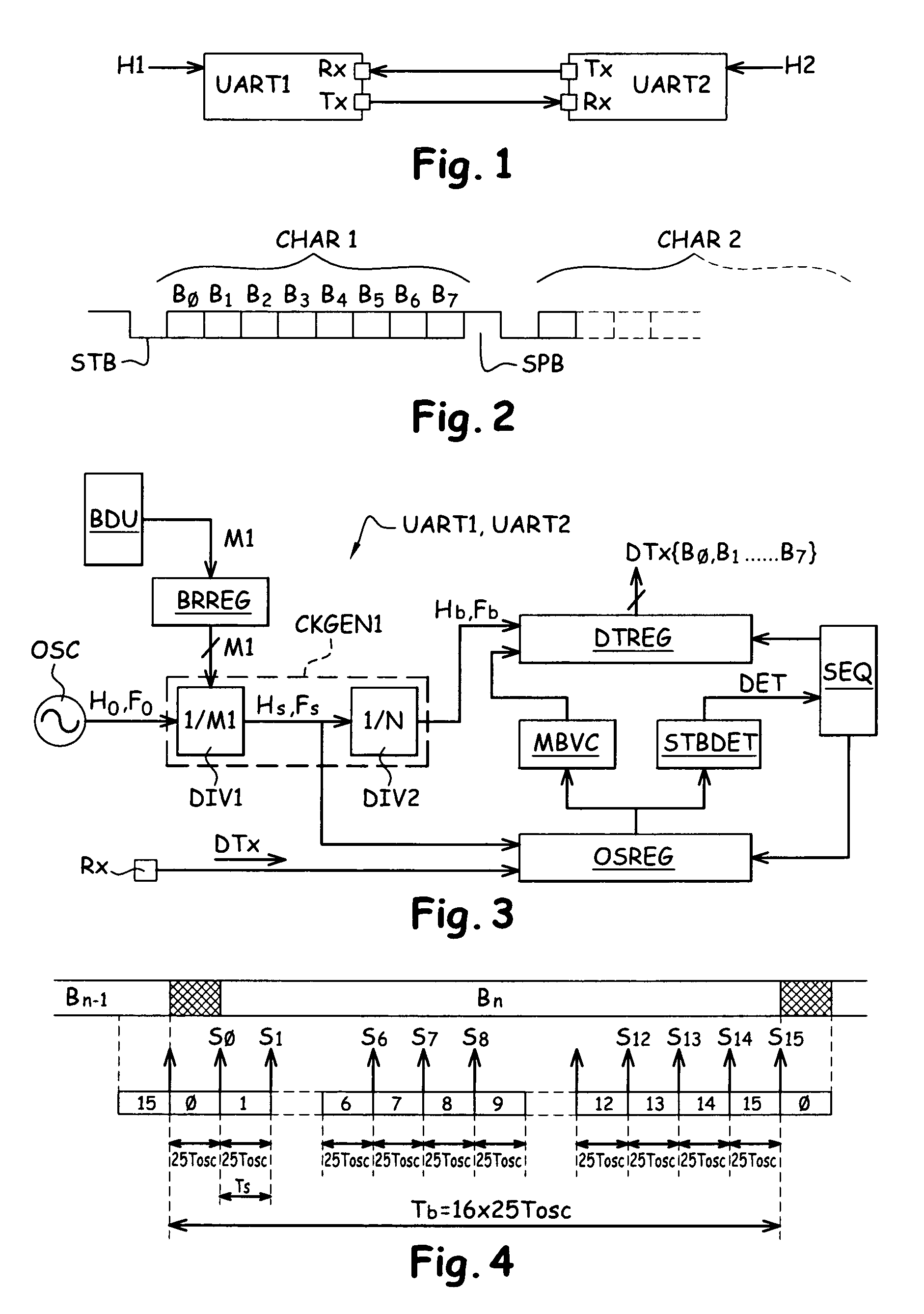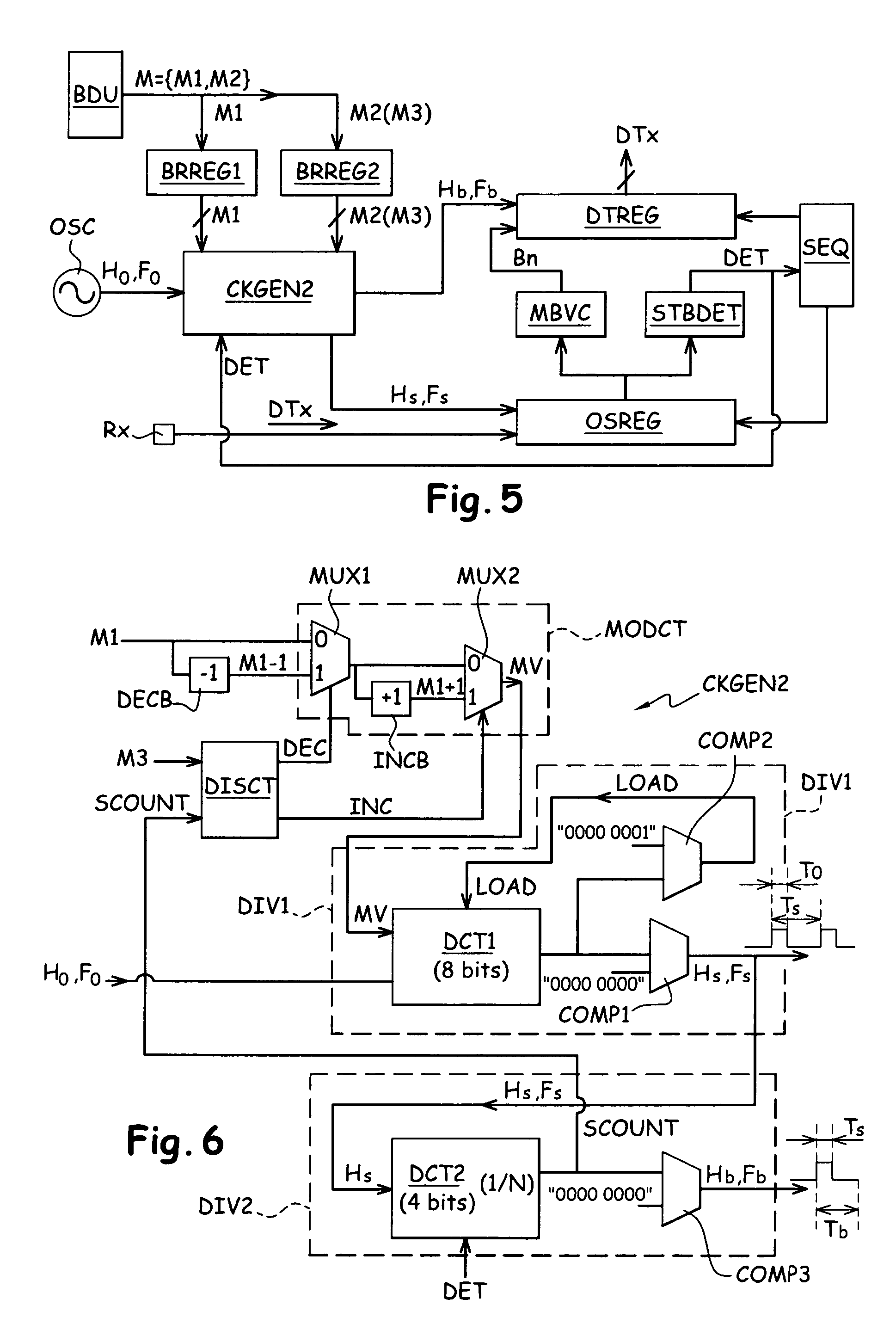Decimal set point clock generator and application of this clock generator to UART circuit
a clock generator and decimal set point technology, applied in pulse generators, electric digital data processing, instruments, etc., can solve the problems of large volume of voltage-controlled oscillators, inability to meet the requirements of synchronization, so as to achieve fine steps and reduce synchronization errors
- Summary
- Abstract
- Description
- Claims
- Application Information
AI Technical Summary
Benefits of technology
Problems solved by technology
Method used
Image
Examples
example a
, FIG. 7
[0200]This example corresponds to the case where M2=+ 1 / 16 (i.e., 0.06). It can be seen that the period of the fourteenth pulse S13 is equal to 26*To while the fifteen other pulses have a period equal to 25*To. In this case:
[0201]M=M1+M2=25.06
[0202]Tb=15*25To+26*To
[0203]Tb=(15*25+26) To
[0204]Tb=401 To
[0205]Fb=Fo / 401
[0206]Tsav=401 / 16 To
[0207]Tsav=25.0625 To
[0208]Fsav=Fo / 25.0625
example b
, FIG. 8
[0209]This example corresponds to the case where M2=+ 2 / 16 (i.e., 0.12). It can be seen that the period of the first pulse SO and of the fourteenth pulse S13 is equal to 26*To (i.e., (M1+1)*To) while the fourteen other pulses have a period equal to 25*To. In this case:
[0210]M=M1+M2=25.12
[0211]Tb=14*25To+2*26*To
[0212]Tb=(14*25+2*26) To
[0213]Tb=402To
[0214]Fb=Fo / 402
[0215]Tsav=402 / 16 To
[0216]Tsav=25.125 To
[0217]Fsav=Fo / 25.125
example c
, FIG. 9
[0218]This example corresponds to the case where M2=− 1 / 16 (i.e., −0.06). The period of the first pulse S0 is equal to 24*To (i.e., (M1−1)*To) while the fifteen other pulses have a period equal to 25*To. In this case:[0219]M=M1+M2=24.94[0220]Tb=15*25To+24*To[0221]Tb=T0(15*25+24) To[0222]Tb=399 To[0223]Fb=Fo / 399[0224]Tsav=399 / 16 To[0225]Tsav=24.9375[0226]Fsav=Fo / 24.9375
[0227]In the examples above, Fsav is the average frequency of the signal Hs over a duration of 16 periods.
[0228]It will be understood by those skilled in the art that the present invention is susceptible of various embodiments and applications.
[0229]In particular, the modulation of the period Ts of the pulses of the oversampling clock signal Hs may be done, as described above, exclusively by positive values (Ts=(M1+1)*To) or exclusively by negative values (Ts=(M1−1)*To).
[0230]The present invention is further susceptible of various applications in fields other than asynchronous data transmissions, and generally ...
PUM
 Login to View More
Login to View More Abstract
Description
Claims
Application Information
 Login to View More
Login to View More - R&D
- Intellectual Property
- Life Sciences
- Materials
- Tech Scout
- Unparalleled Data Quality
- Higher Quality Content
- 60% Fewer Hallucinations
Browse by: Latest US Patents, China's latest patents, Technical Efficacy Thesaurus, Application Domain, Technology Topic, Popular Technical Reports.
© 2025 PatSnap. All rights reserved.Legal|Privacy policy|Modern Slavery Act Transparency Statement|Sitemap|About US| Contact US: help@patsnap.com



